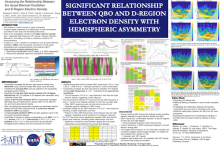ASSESSING THE RELATIONSHIP BETWEEN THE QUASI-BIENNIAL OSCILLATION AND D-REGION ELECTRON DENSITY
Natalie
Wirth
Air Force Institute of Technology
Poster
High-frequency (HF) communication plays a crucial role in military operations, heavily dependent on ionospheric conditions. The D-region, the lowest layer of the ionosphere, significantly influences HF signals due to variations in electron density. While research often delves into the impact of space weather on the upper ionosphere, particularly its higher layers, the D-region remains relatively understudied. Despite its proximity to the troposphere and stratosphere, the D-region is intricately linked to solar events and terrestrial weather patterns. This study addresses the gap in scientific literature by employing Fast Fourier Transforms (FFT), Continuous Wavelet Transforms (CWT), and Cross Wavelet Transforms (XWT). These analyses investigate the relationship between the stratospheric Quasi-Biennial Oscillation (QBO) and the ionosphere D-Region electron density. The FFT analysis reveals a significant association between QBO pressure levels and electron density frequencies, particularly at .33 yr^-1, prevalent across latitudinal bins. The QBO's influence on electron density is statistically significant, particularly during daytime and at lower latitudes. Notably, a consistent phase relationship of approximately -.61 months for the QBO frequency .33 yr^-1 suggests a significant connection, potentially indicating QBO propagation from the upper stratosphere to the lower ionosphere with an 18-day time lag. This newfound understanding holds potential implications for strategic planning and operational adjustments in HF communications reliant upon D-region conditions.

Poster PDF
Poster category
Ionosphere and Thermosphere Research and Applications
Poster session day
Poster location
22
Meeting homepage